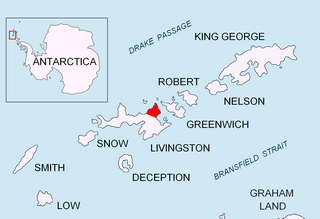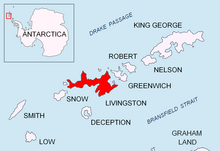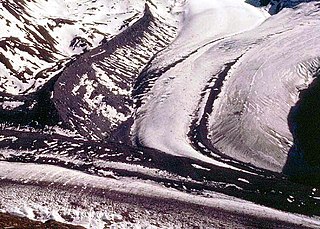
The Atlantic Club Ridge is a ridge rising to 161 m on Hurd Peninsula in Eastern Livingston Island, Antarctica. To the west the ridge surmounts the South Bay coast north of Johnsons Dock, to the south it is bounded by the lower course of the two km long Contell Glacier, to the east by the foot of the Balkan Snowfield sloping up towards Krum Rock and to the northwest by Sea Lion Tarn. The ridge is snow-free in the summer months.

Burdick West Peak rises to 455 m at the northwest extremity of Burdick Ridge in eastern Livingston Island. The peak is partly ice-free.

Kamchiya Glacier is located on Livingston Island in the South Shetland Islands, Antarctica situated south of the glacial divide between the Drake Passage and Bransfield Strait, and south of Tundzha Glacier, west-southwest of Pimpirev Glacier and east of Verila Glacier. The glacier extends 5 km along an east–west axis and is 2.2 km wide, draining into South Bay between Ereby Point and Memorable Beach.

Kresna Gully is a heavily crevassed depression in Perunika Glacier extending 2.25 km westwards from Rezen Knoll in eastern Livingston Island in the South Shetland Islands, Antarctica. The gully ends in the indentation forming the east corner of Emona Anchorage, and located 3.15 km northeast of Hespérides Point 1.21 km south-southeast of Aleko Point.

Nesebar Gap is a 1.3 km wide gap in eastern Livingston Island in the South Shetland Islands, Antarctica bounded to the west by Pliska Ridge and to the east by the northern slope of Mount Friesland, Tangra Mountains. It is part of the divide between the glacial catchments of Perunika Glacier to the north and Huntress Glacier to the south. The gap is part of an overland route between Orpheus Gate to the west, and Camp Academia locality and Lozen Saddle to the east.

Pimpirev Beach is the portion of the northwest coast of South Bay, Livingston Island, Antarctica bounded to the southwest by Ereby Point and to the northeast by the north corner of the bay marked by an ice sea cave located 5.8 km east-northeast of Ereby Point and 1.45 km northwest of Aleko Point.

Pimpirev Glacier on Livingston Island in the South Shetland Islands, Antarctica is situated south of the glacial divide between the Drake Passage and Bransfield Strait, southeast of Tundzha Glacier, southwest of Saedinenie Snowfield, west of Perunika Glacier and east-northeast of Kamchiya Glacier. The feature extends 5.5 km in a southeast-northwest direction, and 1.8 km in northwest-southeast direction. The glacier drains southeastwards towards Pimpirev Beach, mostly terminating on the shore, and on several occasions penetrating the South Bay waters east-northeast of Ereby Point.

Rezen Saddle is a geographical feature on Livingston Island in the South Shetland Islands, Antarctica. The 600 m long horseshoe-shaped flat saddle of elevation 420 m lies between Rezen Knoll and Burdick Ridge in eastern Livingston Island, affording overland access from Balkan Snowfield to upper Perunika Glacier and Bowles Ridge area.

Sea Lion Glacier is the site of an isolated 350 metres (1,150 ft) long glacier on Hurd Peninsula, eastern Livingston Island in the South Shetland Islands, Antarctica. It is located southwest of Hesperides Hill and northwest of Atlantic Club Ridge, separated from the latter by Sea Lion Tarn, and terminating on the South Bay coast.

Varna Peninsula is a roughly rectangular predominantly ice-covered peninsula forming the northeast extremity of Livingston Island in the South Shetland Islands, Antarctica. It is bounded by Hero Bay to the northwest, by Moon Bay to the southeast, and by McFarlane Strait to the northeast.

Chiprovtsi Point is a point projecting 400 m (440 yd) northwestwards from the north coast of Rugged Island off the west coast of Byers Peninsula of Livingston Island in the South Shetland Islands, Antarctica, and forming the east side of the entrance to Nishava Cove. It is extended further 400 m (440 yd) northwestwards by the group of Chiprovtsi Islets, which are centred at 62°36′52″S61°15′49″W and named in association with the point.

Telish Rock is the islet off the south coast of Livingston Island in the South Shetland Islands, Antarctica situated 400 m (437 yd) south of Elephant Point and 3 km (1.86 mi) northwest by west of Enchantress Rocks. Extending 300 by 180 m. The area was visited by early 19th century sealers.

Belchin Rock is a rock off the north coast of Livingston Island in the South Shetland Islands, Antarctica situated in Hero Bay 2.2 km (1.4 mi) northeast of Siddins Point and 2 km (1.2 mi) north of Melta Point.

Zornitsa Cove is the 7 km wide cove indenting for 3.1 km the north coast of Livingston Island in the South Shetland Islands, Antarctica. Entered between Rowe Point and Scesa Point on the west side of Ioannes Paulus II Peninsula. Bulgarian mapping in 2009.

Vergilov Ridge is a submarine ridge in South Bay, Livingston Island in the South Shetland Islands, Antarctica. It extends 3.5 km in a southeast-northwest direction between the Vergilov Rocks and the opposite Pimpirev Beach at a depth of over 50 m, with depths exceeding 100 m on both sides of the ridge. It was formed as a frontal moraine of Perunika Glacier between the 13th and 17th centuries.

Quiroga Ridge is a submarine ridge in False Bay, Livingston Island in the South Shetland Islands of Antarctica. It extends 2.2 km in an east-southeast to west-northwest direction between Ogosta Point on the Rozhen Peninsula and the opposite coast of Hurd Peninsula at a depth of over 50 m, with depths exceeding 100 m on both sides of the ridge. It was formed as a frontal moraine of Huntress Glacier between the 13th and 17th centuries.

Toledo Island is the southern of two rocky islands in Smyadovo Cove on the west coast of Rugged Island in the South Shetland Islands. The feature is 320 m long in east-west direction and 110 m wide. It is separated from Rugged Island to the southeast and Prosechen Island to the north by 40 m and 60 m wide passages respectively. The area was visited by early 19th century sealers.

Prosechen Island is the northern of two rocky islands in Smyadovo Cove on the west coast of Rugged Island in the South Shetland Islands. The feature is 500 m long in east-west direction and 140 m wide. It is separated from Rugged Island to the north and Toledo Island to the south by 70 m and 60 m wide passages respectively. The area was visited by early 19th century sealers.

Kaliman Island is the triangular, flat rocky island extending 250 m in south-southeast to north-northwest direction and 80 m wide in Walker Bay, Livingston Island in Antarctica. It is named after Czar Kaliman Asen of Bulgaria, 1241-1246 AD.















